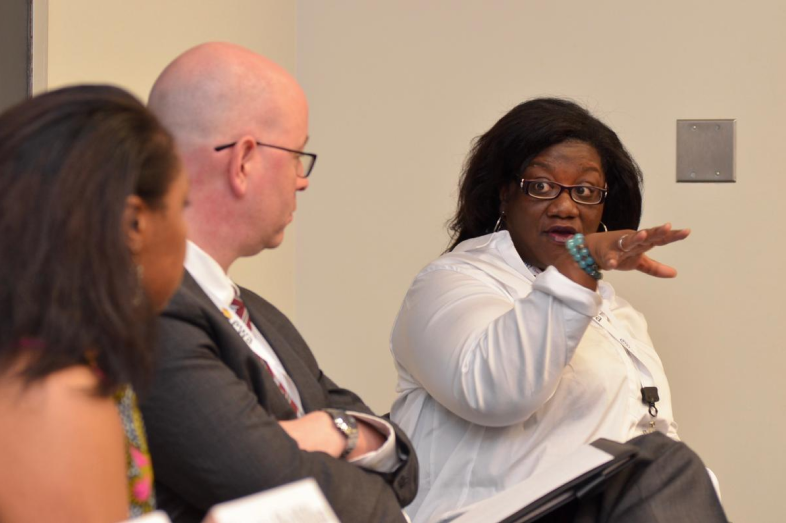

Despite high-profile scandals over cost and credentials, for-profit colleges attract hundreds of thousands of new students each year, enrolling an estimated 10 to 13 percent of higher education students.
Agile in delivery and content, these educational entrepreneurs can pivot to meet demand faster than typically tradition-corseted nonprofit institutions, argued Neal McCluskey of the Cato Institute.
But behind this veil of private enterprise, some common features of for-profit schools, such aggressive student-recruitment practices and uneven accreditation, can make it tough for potential students to judge whether these schools are their best option, countered Tressie McMillan Cottom, sociology professor and author of Lower Ed: The Troubling Rise of For-Profit Colleges in the New Economy.
McCluskey and Cottom faced off this month in a session looking at the future of for-profit colleges at the Education Writers Association National Seminar.
Despite a White House that most critics say appears to lean toward privatization in education, Cottom predicted there will be little or no federal boost for such firms in higher education.
“This is not an education department that looks overly interested in actually functioning,” Cottom said, adding, “I say that, again, just based on the fact that there hasn’t been a lot of interest in staffing it or making it functional, or understanding what the ED does. My conversations with the people who are currently there [indicate] they don’t know what their job is, and they don’t have much of direction from leadership on that. And even on the areas where the ED seems to be interested, they seem to be mostly interested in the K through 12 level. Higher ed, I think, is a side conversation at best.”
In the Obama era, too few students completing degrees (23 percent) at for-profit colleges led to a crackdown on these schools, including limits on underperforming institutions’ access federal student aid, which a Senate study found provided 86 percent of the industry’s revenue.
But stubbornly low completion rates for part-time students at all types of colleges suggest current federal grant and loan programs need to be reconsidered overall, McCluskey said.
“Maybe we shouldn’t be giving everybody every amount of money, or lots of money, to go to basically any school they want because the idea of education generally is good,” he said, noting that only 25 to 40 percent of part-time students – generally the older, working students with families who often enroll in online schools — complete degrees within six years.
“What that suggests is we have a problem that’s much bigger than just one sector of higher education. It may just be that we have completely inflated the purpose of higher education,” McCluskey said.
For-profit colleges greatly expanded in the 1990s, offering quick entry to tech jobs, Cottom said. They reach large numbers of struggling job-seekers, but what they do not always deliver is a credential employers value or four-year universities recognize.
Purdue University in Indiana is attempting to bridge that gap, announcing in April it will acquire for-profit Kaplan University. More than 30,000 students took Kaplan online courses in 2015-16, paying around $34,500 to complete a bachelor’s degree, a company report notes.
The purchase follows a Purdue decision to expand its reach as technology evolves and needs change, said President Mitch Daniels. Under new ownership, Kaplan will become a self-supporting nonprofit with, critically, a new name that includes Purdue.
“It would be an interesting thing to look at,” McCluskey said, “does Kaplan, just even being associated with Purdue, suddenly give their credential higher esteem, even if they aren’t doing anything different?”
The for-profit prestige gap is unlikely to shrink without a reliable measure of quality, some experts have said. Several agencies, with widely differing standards, grant accreditation in the private sphere, so that “fully accredited” does not always mean what the public thinks it does.
A year ago, regulators cut off federal student aid for colleges whose quality assurance rested on the Accrediting Council for Independent Colleges and Schools.
But the move felt largely symbolic, McCluskey said: “What I didn’t get the sense from it was, that there was some sort of powerful, undergirding desire to transform how accrediting is done.”
That is not likely to change, Cottom said. Serious reforms would face formidable legal battles, she said, and “I have just not seen the political will to do that.”
Despite the problems, for-profit colleges continue to out-recruit traditional campuses in niche markets using strategic advertising and a relationship-based sales approach, said Cottom, a former for-profit admissions officer herself.
“If you drive any interstate you’re going to see [public service-type] advertisements for community colleges; they’re just not on ‘Judge Judy,’” Cottom said.
The strong recruiting efforts from for-profit institutions, however, are not mirrored in student retention numbers, noted the Senate study. More than half of students left within four months of starting a for-profit program, many carrying a student-loan debt they could ill afford.
The for-profit sector frames regulation in terms of denying access to better lives, Cottom said. “Student debt really complicates that issue,” she said. “In many ways, access has become an economic problem for poor people because they’re paying so much for something that offers so little in return.”